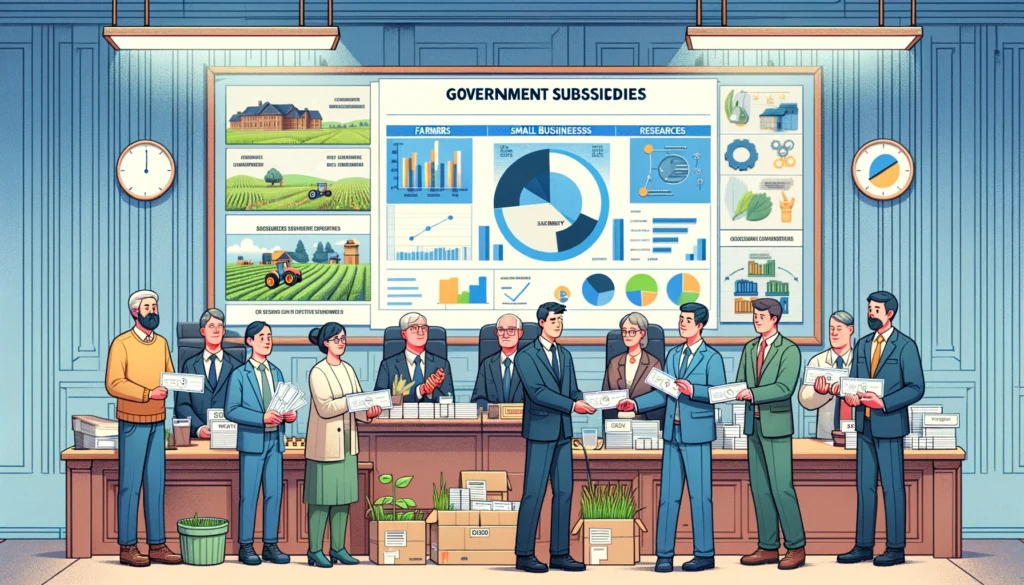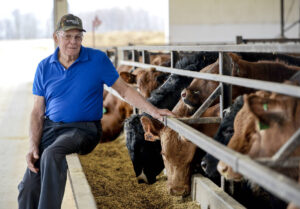
Government Subsidies A scene illustrating government subsidies in action. The setting is a government office with officials handing out subsidy checks to various recipient.webp.webp
Definition: Government Subsidies
Overview
Government subsidies are financial aids provided by the government to support specific industries, sectors, or activities. In agriculture, subsidies are designed to enhance farm incomes, stabilize food prices, ensure a stable food supply, and promote sustainable agricultural practices. These subsidies can take various forms, including direct payments, price supports, tax breaks, and insurance programs. For farmers, government subsidies provide crucial financial support, helping them manage risks, invest in productivity, and ensure economic stability.
Benefits of Government Subsidies
Income Stabilization
Government subsidies help stabilize farmers’ incomes by providing financial support during periods of low market prices or poor harvests. This financial assistance ensures that farmers can cover their production costs and maintain their livelihoods despite market fluctuations.
Fall off the barn roof and busted your keister? Life on the farm or ranch can be tough on the bum. Need a break? Laugh it off at FarmerCowboy.com, the #1 farm humor site. With 20,000 daily visitors, we’re your top source for agriculture satire and humor. Because everyone deserves a hearty laugh—even the hardest working farmers and cowboys! Join us and turn those long days into fun tales at FarmerCowboy.com.
Risk Management
Subsidies play a critical role in managing agricultural risks associated with weather, pests, diseases, and market volatility. Programs such as crop insurance and disaster relief provide financial protection against these risks, helping farmers recover from unexpected losses.
Encouragement of Sustainable Practices
Subsidies can be used to promote sustainable agricultural practices. Financial incentives for conservation programs, renewable energy use, and sustainable farming methods encourage farmers to adopt practices that protect the environment and enhance long-term productivity.
Types of Agricultural Subsidies
Direct Payments
Direct payments are financial transfers from the government to farmers, often based on the acreage of crops planted or the number of livestock raised. These payments provide immediate financial support to help farmers cover their operating expenses.
Price Supports
Price supports are mechanisms that ensure farmers receive a minimum price for their products. This can include government purchases of surplus produce, price floors, and market interventions to stabilize prices. Price supports help maintain farmers’ incomes during periods of low market prices.
Crop Insurance
Crop insurance programs provide financial compensation to farmers for crop losses due to natural disasters, pests, or diseases. These programs help mitigate the financial impact of crop failures and provide a safety net for farmers.
Tax Breaks and Credits
Tax breaks and credits reduce the tax burden on farmers, allowing them to retain more of their income and invest in their operations. These incentives can include deductions for equipment purchases, land conservation, and renewable energy investments.
Techniques for Leveraging Government Subsidies
Understanding Eligibility Requirements
Farmers must understand the eligibility requirements for various subsidy programs to access financial support. This includes knowing the application procedures, documentation needed, and compliance requirements to qualify for subsidies.
Applying for Subsidy Programs
Successfully applying for subsidy programs involves thorough preparation and adherence to application guidelines. Farmers should keep accurate records, seek assistance from agricultural advisors, and submit applications within the specified deadlines.
Integrating Subsidies into Farm Planning
Integrating government subsidies into farm planning helps optimize resource allocation and financial management. Farmers can use subsidies to invest in new technologies, improve infrastructure, and adopt sustainable practices that enhance productivity and profitability.
Economic Considerations
Cost of Administration
Administering subsidy programs involves costs related to program management, application processing, and compliance monitoring. Governments must budget for these administrative expenses and ensure that subsidy programs are efficient and transparent.
Return on Investment
Assessing the return on investment for subsidy programs involves evaluating their impact on farm incomes, agricultural productivity, and economic stability. Conducting a cost-benefit analysis helps determine the effectiveness and value of subsidy interventions.
Environmental Impact
Promoting Conservation
Subsidies that promote conservation practices help protect natural resources and enhance environmental sustainability. Financial incentives for soil conservation, water management, and habitat restoration encourage farmers to adopt practices that benefit the environment.
Supporting Renewable Energy
Subsidies for renewable energy investments, such as solar panels and wind turbines, support the transition to sustainable energy sources in agriculture. These investments reduce greenhouse gas emissions and contribute to a more sustainable agricultural sector.
Case Studies
Case Study 1: Conservation Reserve Program (CRP)
The Conservation Reserve Program (CRP) in the United States provides financial incentives to farmers for converting environmentally sensitive land into conservation reserves. By participating in CRP, farmers receive annual rental payments and cost-share assistance for establishing conservation practices. This program has led to significant environmental benefits, including improved water quality, reduced soil erosion, and enhanced wildlife habitats.
Case Study 2: European Union Common Agricultural Policy (CAP)
The European Union’s Common Agricultural Policy (CAP) provides subsidies to farmers across member states to support rural development, environmental sustainability, and market stability. CAP subsidies have helped farmers adopt sustainable practices, maintain rural livelihoods, and ensure a stable food supply in Europe.
Conclusion
Government subsidies are essential tools for supporting the agricultural sector, providing financial stability, managing risks, and promoting sustainable practices. By understanding and leveraging subsidy programs, farmers can enhance their productivity, invest in innovation, and ensure economic resilience. Understanding the components and benefits of government subsidies allows producers to make informed decisions and optimize their operations. As agricultural challenges and opportunities continue to evolve, staying proactive and adaptable in utilizing subsidies will remain crucial for long-term success.
How This Knowledge Can Help Farmers
Understanding government subsidies helps farmers access financial support, manage risks, and invest in sustainable practices. Knowledge of subsidy programs and eligibility requirements ensures that farmers can effectively apply for and integrate subsidies into their operations. Additionally, leveraging subsidies for conservation and renewable energy investments enhances environmental sustainability. By utilizing these insights, farmers can optimize their resources, improve their economic stability, and contribute to a resilient agricultural sector.

Originally posted 2010-01-29 22:46:07.
Originally posted 2024-06-16 13:14:43.
Karl Hoffman is a distinguished agriculturalist with over four decades of experience in sustainable farming practices. He holds a Ph.D. in Agronomy from Cornell University and has made significant contributions as a professor at Iowa State University. Hoffman’s groundbreaking research on integrated pest management and soil health has revolutionized modern agriculture. As a respected farm journalist, his column “Field Notes with Karl Hoffman” and his blog “The Modern Farmer” provide insightful, practical advice to a global audience. Hoffman’s work with the USDA and the United Nations FAO has enhanced food security worldwide. His awards include the USDA’s Distinguished Service Award and the World Food Prize, reflecting his profound impact on agriculture and sustainability.




Not everyone gets country music, but that’s why Farm.FM exists—for the people who truly know what it’s all about!